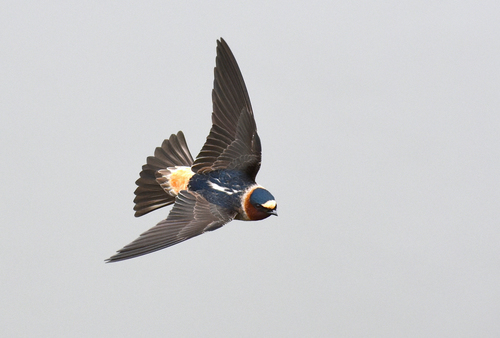
Cliff Swallow
The Cliff Swallow (*Petrochelidon pyrrhonota*) is a migratory bird known for its remarkable mud nests and highly social behavior. These birds are often found in large colonies, sometimes numbering in the thousands, near cliffs, bridges, and other structures that provide suitable nesting sites. They play a vital role in controlling insect populations, consuming vast quantities of flying insects. Cliff Swallows have cultural significance in some regions, with their return often heralding the arrival of spring.
13-15 cm
Length
26-29 cm
Wingspan
Least Concern
Conservation Status
Distribution
Breeds across much of North America, from Alaska and Canada south to Mexico. Winters in South America, primarily in the southern cone countries like Argentina, Paraguay, and Uruguay. Migrates through Central America and the Caribbean.
Lifespan
Average 4-6 years in the wild; up to 11 years recorded.
Cliff Swallow's Habitat
Habitat Types
Open Country, Grasslands, Agricultural Areas, Near Water Bodies (rivers, lakes), Cliffs and Canyons, Human-made structures (bridges, buildings)
Climate Zones
Temperate, Subtropical, Tropical (during migration and wintering)
Adaptations
Their preference for nesting on vertical surfaces, whether natural cliffs or human-made structures, is a key adaptation. They require a source of mud of the correct consistency and a nearby water source for nest building.
Variations
Several subspecies are recognized, differing slightly in size and plumage coloration, with variations often linked to geographic location.
Appearance
Breeding Plumage
Breeding plumage is more vibrant. Non-breeding plumage is slightly duller.
Seasonal Feather Changes
Some seasonal variation, mostly in glossiness and intensity of colors.
Sex Based Plumage Differences
Males tend to have slightly brighter and more contrasting plumage, particularly on the forehead and throat, but the differences are subtle.
Notable Features
Square tail, Pale, buffy rump patch, Dark throat with a chestnut-colored 'bib', White forehead (varies in brightness among subspecies)
Diet and Feeding
Primary Foods
Flying insects (flies, beetles, wasps, bees, ants), Spiders (occasionally)
Foraging Behavior
Forages in flight, often in large flocks, catching insects on the wing. They are agile fliers, capable of rapid turns and dives.
Specializations
Their wide gape and maneuverability in flight are adaptations for catching insects mid-air.
Seasonal Diet Variations
Diet is primarily insectivorous year-round, but the specific types of insects consumed may vary based on availability and location.
Behavior
Social Structure
Highly colonial, nesting in large groups that can number in the thousands. They also forage and migrate in flocks.
Communication
Complex vocalizations, including chirps, twitters, and squeaks., Visual displays, such as wing fluttering and tail spreading.
Migration
Long-distance migrants, traveling thousands of miles between breeding and wintering grounds. They typically migrate during the day, often in large flocks.
Territorial or Group Behaviors
While colonial, pairs defend a small territory immediately around their nest. They often cooperate in mobbing predators.
Conservation
Threats
Habitat loss (due to urbanization and changes in agricultural practices), Pesticide use (reducing insect prey), Climate change (potentially affecting migration timing and prey availability), Destruction of nests (often considered a nuisance by some homeowners)
Protection Programs
Migratory Bird Treaty Act (in the US), Species at Risk Act (in Canada)
Local National Laws
Protected under various state and provincial wildlife laws.
Population Trend
Stable
Population Estimates
Global population estimated to be around 90 million individuals.
Interesting Facts
They build their nests with mud pellets.
Each nest can contain 900-1,200 individual mud pellets, collected one at a time by the birds.
Cliff Swallows are highly social.
They often nest in colonies containing hundreds or even thousands of nests.
They are long-distance migrants.
They travel thousands of miles between their breeding grounds in North America and their wintering grounds in South America.
Cliff Swallows sometimes use old nests.
Old nests can be refurbished and reused in subsequent years, saving the birds time and energy.
Cliff Swallows are parasitized by other birds.
House Sparrows sometimes take over Cliff Swallow nests, and Brown-headed Cowbirds may lay their eggs in Cliff Swallow nests (brood parasitism).
Faqs about Cliff Swallow
What do Cliff Swallows eat?
Cliff Swallows eat flying insects, which they catch in flight.
Where do Cliff Swallows nest?
Cliff Swallows build mud nests on vertical surfaces, such as cliffs, bridges, and buildings.
Are Cliff Swallows endangered?
No, Cliff Swallows are classified as 'Least Concern' by the IUCN.
How long do Cliff Swallows live?
The average lifespan of a Cliff Swallow is 4-6 years, but some individuals can live up to 11 years.
How can I attract Cliff Swallows?
Provide a suitable nesting surface (vertical, with an overhang) and a source of mud nearby. Avoiding pesticide use will also help by ensuring a healthy insect population.
Copyright @ Nature Style Limited. All Rights Reserved.
 English
English